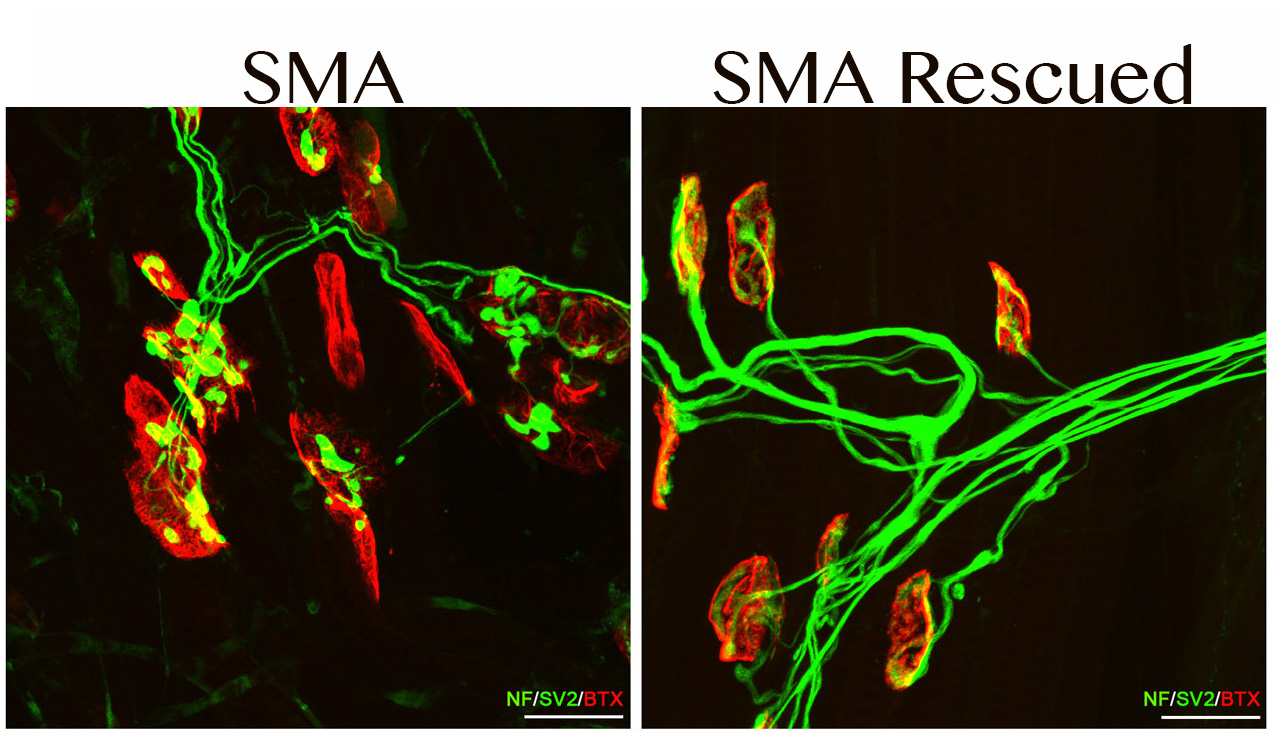
“These pictures show connections between muscle (red) and nerve (green), known as neuromuscular junctions, from mouse models of SMA,” Murray says. “In the untreated SMA mouse model (left) they look really unhealthy. For example, there are some red patches marking the muscle lacking neurons, indicating that the neuron has been lost. When this mouse model is treated to allow correction of the genetic defect, the neuromuscular junctions are able to recover and look much healthier (right). We aim to understand how quickly this process of recovery happens and whether the neuromuscular junctions can recover to the same extent when the damaged gene is repaired later in disease.”
Lyndsay Murray, a lecturer in anatomy at the University of Edinburgh in Scotland was awarded an MDA research grant totaling $292,174 over a period of three years to investigate how the mechanisms underlying spinal muscular atrophy (SMA) influence how therapies work at different stages of the disease.
 In animal model studies, it has been shown that while treatment can nearly rescue an individual from the disease when given before symptoms begin, the benefits are drastically reduced when therapies are given after symptom onset.
In animal model studies, it has been shown that while treatment can nearly rescue an individual from the disease when given before symptoms begin, the benefits are drastically reduced when therapies are given after symptom onset.
With colleagues, Murray will conduct studies in a mouse model of SMA that are aimed at determining why the benefits of therapeutics are so limited after symptoms have started and finding ways to maximize the benefits of these therapies during symptomatic stages of the disease. The work is expected to inform development of more effective therapies and increase understanding of when and why they have to be administered.
Please describe your current research.
In this project, we will use a mouse model of SMA to investigate how quickly a motor neuron can repair itself when a candidate therapeutic is given. We will then investigate what problems in the motor neurons cannot be fixed when the candidate therapeutic is given later in the disease. Finally, we will investigate whether other drugs can be given in combination to help motor neurons repair themselves when the treatment is given during symptomatic stages of the disease.
This work has important implications for the development of therapies for SMA. It will help us understand more precisely how these candidate therapeutics affect the motor neurons. It will also help us understand what limits the benefits of the therapeutics and inform our investigation into ways to make them work better.
Is this your first MDA grant?
No, it is not my first MDA grant. I was fortunate to be the recipient of an MDA development grant in 2014. That grant coincided with the establishment of my own lab and has provided critical funding for research over the past two-plus years. This new grant is of huge significance as not only does it provide key funding for research in my young laboratory for the next three years but it also provides a postdoctoral researcher to work on the project. Having an additional experienced researcher on the team greatly increases the number of students we can recruit and supervise and makes a huge difference to our productivity.
What inspired you to study SMA?
The SMA research community has an amazing atmosphere — highly collaborative and very supportive to junior investigators. Scientifically, it is also at a very exciting time, with the number of clinical trials steadily increasing.
What is your focus within the SMA field, and why is it important?
My lab works predominantly on mouse models of SMA. It is our goal to understand how and when motor neurons get sick and use that information to develop and test new ways to protect them.
Understanding when and where the disease starts gives us important insight into the reasons for the disease and helps us understand how a mutation in a gene can lead to a paralytic disease. This information is crucial for developing more efficacious therapies and fully understanding when and why they have to be administered.
What do you feel people impacted by SMA can have the most hope about with respect to research right now?
The significant amount of research over the past 20 years in the SMA field has resulted in clinical trials and the number of clinical trials are increasing annually. Progress is inevitably slower than we would all like, but we are gradually moving towards treatments for SMA which, one day, will make a real difference.
Does your work have any potential implications for other disease fields?
Yes, absolutely. Everything we learn about SMA has relevance to other motor neuron diseases. There is more and more evidence that there is significant overlap between motor neuron diseases. Even if a therapeutic is not directly transferable, the knowledge we gain can help therapeutic development in other fields.
To learn more about how MDA research is accelerating treatments and cures for SMA, please visit mda.org.
